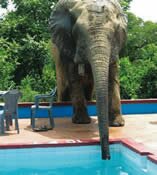Inflight Magazine of Brussels Airlines
Welcome to the Inflight Magazine of Brussels Airlines
In Africa
Images Panos, Axiom, 4Corners
Explore further with Brussels Airlines: from early July we’ll be flying to four new destinations – Ghana, Benin, Burkina Faso and Togo – where fascinating landscapes, people and beliefs await you

Explore the natural landscape: rock formations at Tounte Polaka in Burkina Faso

Make a connection with the people: three children collecting water in Ghana

Experience local culture and beliefs: pastors entering a church in Lomé, in the Maritime region of Togo
The experiences to be had in these new destinations are as diverse as the countries themselves
 Benin
Benin
Novotel Cotonou Orisha
Where is it?
Right on the seafront in the centre of Cotonou (www.novotel.com), well placed for the airport and the conference centre.
What’s the view?
You might be situated just minutes from the Palais des Congrès and the centre of the city, but ask for a room with sea views and you won’t be looking back.
What is there to do?
The question should be ‘what is there not to do?’ Apart from exploring the beach in front of the hotel and enjoying local boat excursions or deep-sea fishing, you could relax and enjoy the sunshine from one of the luxurious poolside cabanas, or within half an hour of the complex you’ll find a golf course, horse riding, the Musée de Porto Novo, an amusement park, the stadium and sports centre. If you’re prepared to travel an extra few kilometres, you could even visit Cotonou Zoo.
How much does it cost?
Doubles from €112.
 Ghana
Ghana
Elephants at Mole National Park
For the best safari opportunity in the country head to 5,000km2 Mole (pronounced ‘Moh-lay’) National Park, where you can relax and unwind by the pool of the Mole Motel and watch elephants, buffalo, monkeys and other wildlife go by. Perched on a hill between two elephant watering holes, it’s very rare that an animal will approach the motel, but the pachyderm otherwise known as People’s Friend is so called because he’s the park’s only wild African elephant that people can approach without risk of attack.
 Togo & Burkina Faso
Togo & Burkina Faso
Experiencing the local music scene in West Africa should be as important a part of your journey as a safari through the Serengeti or trip to the vineyards of South Africa
Togo can claim a rich musical history, particularly from the Kabyé in the north of the country. Some of the most interesting instruments are used for special occasions only, such as the picancala, a xylophone-like instrument made of stones, and the xokudu, a trumpet-type instrument made from the fruit of the baobob tree.
Burkina Faso, meanwhile, offers a large variety of musical styles that are calling out to be enjoyed. Complex drumming and balafons (xylophones) are characteristic, and dance is an exceptionally important part of the ritual. If you want to enjoy the best of the Burkinabé music you would be advised to head to the town of Bobo-Dioulasso, where every even-numbered year in February or March they hold the Semaine Nationale de la Culture festival, which offers a tremendous spectacle for dance and percussion enthusiasts.
Insider tips
How to get more from your African adventure
Bren McVay from B-Africa Tours has these tips to ensure that the practicalities look after themselves, allowing you to enjoy African hospitality:
Pack light
Make sure you bring a minimal, but appropriate, amount of clothing, as this will make travel through airports and beyond much easier.
Go native
It is the local custom in most West African countries to negotiate when shopping in open markets, so feel free to haggle. Look out for locally-made, attractive and durable hats and clothing that are reasonably priced, plus good sunglasses.
Speak up
Don’t be afraid of getting involved. West Africans are a very friendly and engaging group of people. www.b-africatours.com
Leave a Reply
